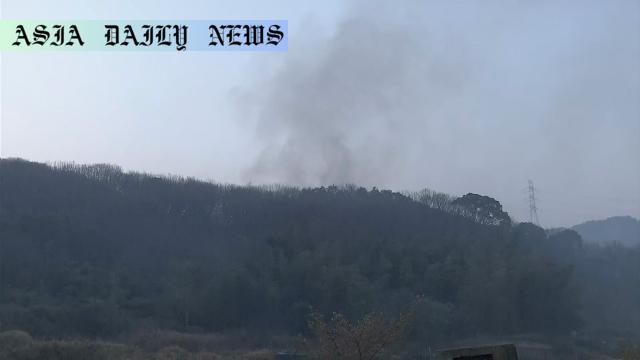Wildfires rage in Okayama as blazes persist for five days, burning 559 hectares. Authorities and SDF continue combating the flames.
Wildfires have burned 559 hectares in Okayama, the largest in its history.
Six structures, including homes, are damaged but no injuries reported.
Self-Defense Forces and firefighters are continuously battling flames.
Evacuation orders remain for nearby districts as efforts continue.
Rain is forecasted, but uncertain if it will help control the fires.

Unprecedented Wildfires Strike Okayama Prefecture
For five consecutive days, the city of Okayama in western Japan has been battling one of its most destructive natural disasters. These wildfires, which have already consumed 559 hectares of forests, are being recorded as the largest in the history of Okayama Prefecture. Structures, including residential houses and warehouses, have succumbed to the flames, and though there have yet to be any reported injuries, the damage to property and the environment is concerning. The disaster has brought a combined response from local firefighters and the Japanese Self-Defense Forces (SDF), who have been tirelessly attempting to contain the fires by ground and air.
Evacuation and Persistent Challenges
Residents in the affected districts, particularly Kogushi in Okayama’s Minami Ward and Banda and Kitagata in neighboring Tamano City, have been under evacuation orders for safety reasons. As of Thursday morning, four individuals were using a shelter in Okayama City for refuge, while black smoke continues to rise ominously from the nearby mountains, evidence of persistent hotspots and reignited flames aided by strong winds. With sparks frequently blowing to uncontaminated areas, firefighting teams are working round the clock to prevent the fires from spreading toward residential zones.
Efforts to Combat the Blazes
Over the past several days, SDF helicopters have played a crucial role, working tirelessly since the early hours of each day to deliver water to the fire-affected zones. These measures, combined with efforts of ground personnel, have yielded some progress; in some areas like the Miyaura district, flames are no longer visible. However, the presence of black smoke indicates that a complete extinguishment is far from realized. Firefighters vigilantly remain on standby to address any re-ignition promptly. Unfortunately, unpredictable weather conditions exacerbate challenges, and while rain is forecasted, it is uncertain whether it will be sufficient to provide relief.
Broader Impacts and Concerns
Beyond the immediate threats to life and property, these wildfires are a stark reminder of the escalating environmental challenges many regions in the world are facing due to climate volatility. Okayama’s beautiful landscape, rich in forests and natural habitats, has suffered severe damage, raising concerns over biodiversity loss and long-term environmental consequences for the region. Additionally, efforts to rebuild and reestablish normalcy for affected residents will require extensive resources and coordination among local and governmental authorities.
Looking Forward Amidst Uncertainty
The resilience of the Okayama community, combined with relentless efforts by first responders, is commendable. However, much remains to be done to contain the fires fully and assess the extent of the damage. As authorities remain hopeful about potential rainfall easing their challenges, they are also urging residents to remain vigilant and follow safety directives. The Okayama wildfires serve as a sobering example of how rapidly such disasters can escalate, demanding robust response mechanisms and preventive strategies at local and global levels.



Commentary
The Unyielding Force of Nature
The ongoing devastation in Okayama Prefecture is a striking reminder of nature’s unforgiving power and the vulnerabilities of human settlements in its path. Watching the relentless progression of these fires, one cannot help but reflect on the delicate balance of ecosystems and the impact of modern human activity on our environment. These wildfires highlight how susceptible even the most developed regions are to the forces of nature, and they underscore the importance of preparation and response mechanisms to tackle such crises.
The Role of Resilience in Disaster Response
Amidst the chaos, the resilience and determination of the local authorities, Self-Defense Forces, and firefighters have been nothing short of inspiring. Their tireless efforts to secure lives, properties, and landscapes provide a glimmer of hope amidst the unfolding tragedy. Additionally, the affected communities’ ability to adapt to evacuation protocols and seek refuge reflects the human spirit’s indomitable strength even in adversity. Yet, as commendable as these efforts are, the scale of the disaster signals the need for more proactive measures and enhanced disaster response frameworks in the future.
A Global Wakeup Call
Beyond Okayama, such incidents resonate with a global audience. Wildfires have become all too common in recent years, often fueled by changing climatic patterns and human activities. These events should serve as critical wakeup calls, urging governments, organizations, and individuals to prioritize ecological preservation and sustainable living practices. As emergency responders continue combating the blazes in Okayama, the international community should take a moment to evaluate its role in mitigating such disasters and fostering resilience in at-risk areas.